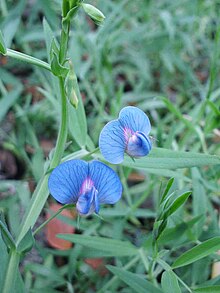Lathyrus sativus, also known as grass pea, cicerchia, blue sweet pea, chickling pea, chickling vetch, Indian pea,[2] white pea[3] and white vetch,[4] is a legume (family Fabaceae) commonly grown for human consumption and livestock feed in Asia and East Africa.[5] It is a particularly important crop in areas that are prone to drought and famine, and is thought of as an 'insurance crop' as it produces reliable yields when all other crops fail. The seeds contain a neurotoxin that causes lathyrism, a neurodegenerative disease, if eaten as a primary protein source for a prolonged period.
| Lathyrus sativus | |
|---|---|
 | |
| Scientific classification | |
| Kingdom: | Plantae |
| Clade: | Tracheophytes |
| Clade: | Angiosperms |
| Clade: | Eudicots |
| Clade: | Rosids |
| Order: | Fabales |
| Family: | Fabaceae |
| Subfamily: | Faboideae |
| Genus: | Lathyrus |
| Species: | L. sativus |
| Binomial name | |
| Lathyrus sativus | |
| Synonyms[1] | |
|
List
| |
Cultivation
Lathyrus sativus grows best where the average temperature is 10–25 °C and average rainfall is 400–650 mm (16–26 in) per year. Like other legumes, it improves the nitrogen content of soil. The crop can survive drought or floods,[4] but grows best in moist soils. It tolerates a range of soil types from light sandy through loamy to heavy clay, and acid, neutral, or alkaline soils. It does not tolerate shade.[6]
Slow Food inducted Serra de'Conti Cicerchia, a cicerchia grown in Serra de’ Conti Municipality, Ancona Province, Marche region of Italy into the Ark of Taste.[7]
Uses

Seed is sold for human consumption at markets in Florence. Consumption of this pulse in Italy is limited to some areas in the central part of the country, and is steadily declining.[citation needed]
Flour made from grass peas (Spanish: almorta) is the main ingredient for the gachas manchegas or gachas de almorta.[8] Accompaniments for the dish vary throughout La Mancha. This is an ancient Manchego cuisine staple, generally consumed during the cold winter months. The dish is generally eaten directly out of the pan in which it was cooked, using either a spoon or a simple slice of bread. This dish is commonly consumed immediately after removing it from the fire, being careful not to burn one's lips or tongue.[citation needed]
Due to its toxicity, it was forbidden for human consumption in Spain from 1967[9] to 2018.[10] However, it was widely sold as animal feed, but displayed together with flours for human consumption.[11]
The town of Alvaiázere in Portugal dedicates a festival lasting several days to dishes featuring the pulse. Alvaiázere calls itself the Chícharo capital, the name of this pulse in Portuguese.
Immature seeds can be eaten like green peas. Mature seeds need soaking and thorough cooking to reduce toxins.[6]
The leaves and stem are cooked and eaten as chana saga (Odia: ଚଣା ଶାଗ) in parts of Odisha, India.
Neurotoxic properties

Like other grain legumes, L. sativus produces a high-protein seed. The seeds however also contain variable amounts of a neurotoxic amino acid β-N-oxalyl-L-α,β-diaminopropionic acid (ODAP).[12][13] ODAP is considered the cause of the disease neurolathyrism, a neurodegenerative disease that causes paralysis of the lower body: emaciation of gluteal muscle (buttocks).[4] The disease has historically occurred after famines in Europe (France, Spain, Germany), North Africa, and South Asia, and is still prevalent in Eritrea, Ethiopia, and Afghanistan (panhandle) when Lathyrus seed is the exclusive or main source of nutrients for extended periods. ODAP concentration increases in plants grown under stressful conditions, compounding the problem.
The crop is harmless to humans in small quantities, but eating it as a major part of the diet over a three-month period can cause permanent paralysis below the knees in adults and brain damage in children, a disorder known as lathyrism. (Kew Gardens)[4]
Some authors have argued that this toxicity is overstated, and L. sativus is harmless as part of a normal diet.[14][15]

Goya in his 1810-1815 The Disasters of War series illustrates the harm that can be done by excessive consumption of grass peas in times of famine in his print Gracias á la almorta (Thanks to the grass pea),[16] about Napoleon's siege of Madrid. It depicts a woman who can no longer walk due to lathyrism, surrounded by starving people waiting for bowls of grass pea-based food.[17] Grass-pea products were banned for sale for human consumption in Spain from 1967 to 2018, due to toxicity.
This legume is the only known dietary source for L-homoarginine[citation needed] and is preferred[by whom?] over arginine for nitric oxide (NO) generation. L-ODAP is reported to act as an activator of calcium-dependent protein kinase C.[needs context]
Breeding programs

Breeding programs are underway to produce lines of Lathyrus sativus that contain ODAP levels too low to be dangerous, while maintaining disease and insect resistance and tolerance to drought, heat, and salinity.[18][19][17]
Certain varieties from western Asia have a low level of the neurotoxin and breeders and farmers are now exploring this genetic diversity to develop varieties that maintain the tolerance to extreme conditions, while at the same time achieving a safe level of the toxic compound.[20]
Wild relatives are a prominent source of genetic material to improve cultivars. From 2016 to 2018, the International Center for Agricultural Research in the Dry Areas (ICARDA) evaluated wild relatives[21] to explore genes for low or no ODAP and resistance/tolerance to biotic/abiotic stresses and transfer them to cultivated grass pea.[22]
References
External links
Wikiwand in your browser!
Seamless Wikipedia browsing. On steroids.
Every time you click a link to Wikipedia, Wiktionary or Wikiquote in your browser's search results, it will show the modern Wikiwand interface.
Wikiwand extension is a five stars, simple, with minimum permission required to keep your browsing private, safe and transparent.
